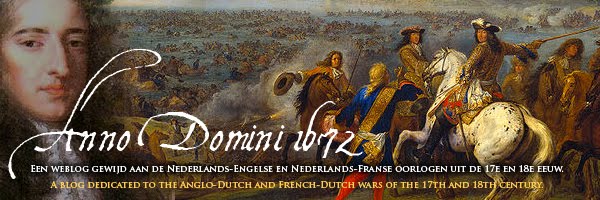
Dit plaatje is van een marinier in Nieuw Amsterdam in 1673 en komt uit de Osprey 'American Colonial Troops'. De afbeelding is echter afgeleid (bijna letterlijk) van een artikel uit 1971 van The Company of Military Historians, die hun info weer hebben gehaald uit Ph. Bosscher's ' De Nederlanse Mariniers' , (Bussum 1966) en uit info van correspondenten uit Nederland.
Ook in het boek 'Military Dress of North America, 1665-1970' , is een afbeelding te vinden - met begeleidende tekst van een Luitenant van de mariniers.
Waar de bronnen het allemaal over eens zijn is het volgende: de rok met 16 tinnen knopen was blauw en had geen kraag. De mouwomslagen waren geel met drie knopen. Onder de rok een wit linnen hemd met kraag die dan weer over de rok werd geslagen, bij de mouwen een band om het hemd af te sluiten.
De kniebroek hadden een gesp zo bij de knie en de kleuren varieerden van bruin, tot grijs of rood. De lange wollen sokken waren blauw of grijs en de schoenen waren van bruin leer. De hoed was bruin.
Officieren droegen nog een oranje band of sjaal rond het midden en zij droegen een ringkraag in verschillende kleuren om de rand aan te duiden. Onderofficieren hadden nog een soort witte epaulet en hogere officieren droegen nog een witte das. Mariniers waren sinds 1665 bewapend met een snaphaan, de voorloper van het vuursteenmusket.
Met dank aan Drs. C.B. Nicolas.
~~
The above pic of a Dutch marine comes from the Osprey on colonial american troops, representing one of the marines that recaptured New Amsterdam in 1673. The info is derived (to put it mildly) from an article in 1971 by Chapman and Nyland in the Journal of the Company of Military Historians.
Their info comes from Bosscher's book on the marines from 1966 and from correspondence with the dutch MOD and the Dutch Armymuseum.
(As a side note: the marine is standing in front of a dutch looking building, but in my view the bricks are drawn too big and look too english. This makes a lot of wargames buildings made in the UK rather useless for the Low Countries).
The sources agree the uniform consisted of a blue 'justacorps'. Chapman and Nyland add that the uniform had 16 pewter buttons, and a yellow cuff with three buttons. Shoes and hats were brown and the breeches could be brown, grey or red. The socks could be grey or blue wool. Leatherwork was brown.
Additional info comes from Windrow's 'Military Dress of North America, 1665-1970' (ISBN 07110-0468-4) which describes the officers in detail: they wore an orange sash around the waist, and had a ring collar with a velvet back piece in different colours. Lower ranking officers had a white lace ' distinction' to denote rank on the right shoulder. Officers could wear boots and gloves in finer leather. Officers also wore a 'cravatte'.
From their foundation in 1665, the marines were armed with ' snaphaunces' , the predecessor of the flintlock, or the flintlocks themselves.
Many thanks to Drs. C.B. Nicolas.




Geen opmerkingen:
Een reactie posten
Opmerking: Alleen leden van deze blog kunnen een reactie posten.